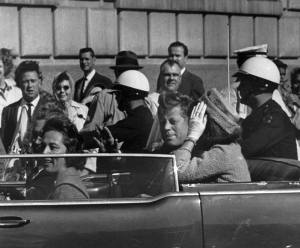JFK assassination files released, sending history buffs hunting for new
clues
[March 19, 2025]
By JAMIE STENGLE
DALLAS (AP) — More than 63,000 pages of records related to the 1963
assassination of President John F. Kennedy were released Tuesday
following an order by President Donald Trump, many without the
redactions that had confounded historians for years and helped fuel
conspiracy theories.
The U.S. National Archives and Records Administration posted to its
website roughly 2,200 files containing the documents. The vast majority
of the National Archives' collection of over 6 million pages of records,
photographs, motion pictures, sound recordings and artifacts related to
the assassination have previously been released.
Larry J. Sabato, director of the University of Virginia Center for
Politics and author of “The Kennedy Half-Century,” said it will take
time to fully review the records.
“We have a lot of work to do for a long time to come, and people just
have to accept that,” he said.
Trump announced the release Monday while visiting the John F. Kennedy
Center for the Performing Arts in Washington, saying his administration
would be releasing about 80,000 pages.
“We have a tremendous amount of paper. You’ve got a lot of reading,”
Trump said.
Before Tuesday, researchers had estimated that 3,000 to 3,500 files were
still unreleased, either wholly or partially. And just last month the
FBI said it had discovered about 2,400 new records related to the
assassination.
Jefferson Morley, vice president of the Mary Ferrell Foundation, a
repository for files related to the assassination, said in a statement
posted on the social platform X that the release is “an encouraging
start.” He said much of the “rampant overclassification of trivial
information has been eliminated” from the documents.

The National Archives said on its website that in accordance with the
president’s directive, the release would encompass “all records
previously withheld for classification.” But Morley said what was
released Tuesday did not include two-thirds of the promised files, any
of the recently discovered FBI files or 500 Internal Revenue Service
records.
"Nonetheless, this is the most positive news on the release of JFK files
since the 1990s,” Morley said.
Interest in details related to Kennedy's assassination has been intense
over the decades, with countless conspiracy theories spawned about
multiple shooters and involvement by the Soviet Union and mafia.
He was killed Nov. 22, 1963, on a visit to Dallas, when his motorcade
was finishing its parade route downtown and shots rang out from the
Texas School Book Depository building. Police arrested 24-year-old Lee
Harvey Oswald, who had positioned himself from a sniper’s perch on the
sixth floor. Two days later nightclub owner Jack Ruby fatally shot
Oswald during a jail transfer.
A year after the assassination, the Warren Commission, which President
Lyndon B. Johnson established to investigate, concluded that Oswald
acted alone and that there was no evidence of a conspiracy. But that
didn’t quell a web of alternative theories over the decades.
[to top of second column]
|

This Nov. 22, 1963 file photo shows President John F. Kennedy riding
in motorcade with first lady Jacqueline Kenndy in Dallas, Texas. (AP
Photo, file)

Oswald was a former Marine who defected to the Soviet Union before
returning home to Texas.
Files in the new release included a memo from the CIA’s St.
Petersburg station from November 1991 saying that earlier that
month, a CIA official befriended a U.S. professor there who told the
official about a friend who worked for the KGB. The memo said the
KGB official had reviewed “five thick volumes” of files on Oswald
and was “confident that Oswald was at no time an agent controlled by
the KGB.”
The memo added that as Oswald was described in the files, the KGB
official doubted “that anyone could control Oswald, but noted that
the KGB watched him closely and constantly while he was in the
USSR.” It also noted that the file reflected that Oswald was a poor
shot when he tried target firing in the Soviet Union.
In the early 1990s, the federal government mandated that all
assassination-related documents be housed in a single collection in
the National Archives and Records Administration. The collection was
required to be opened by 2017, barring any exemptions designated by
the president.
Trump, who took office for his first term in 2017, had said that he
would allow the release of all of the remaining records but ended up
holding some back because of what he called the potential harm to
national security. And while files continued to be released during
President Joe Biden’s administration, some remained unseen.
Sabato said that his team has a “long, long list” of sensitive
documents it is looking for that previously had large redactions.
“There must be something really, really sensitive for them to redact
a paragraph or a page or multiple pages in a document like that,” he
said. “Some of it’s about Cuba, some of it’s about what the CIA did
or didn’t do relevant to Lee Harvey Oswald.”
Some of the previously released documents have offered details on
the way intelligence services operated at the time, including CIA
cables and memos discussing visits by Oswald to the Soviet and Cuban
embassies during a trip to Mexico City just weeks before the
assassination.
___
Associated Press writer John Hanna contributed from Topeka, Kansas.
All contents © copyright 2025 Associated Press. All rights reserved
 |